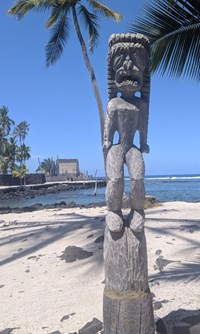- Great Basin National Park (10)
- Buffalo National River (8)
- Carlsbad Caverns National Park (6)
- Mammoth Cave National Park (5)
- Timpanogos Cave National Monument (4)
- Wind Cave National Park (4)
- Puʻuhonua o Hōnaunau National Historical Park (3)
- El Malpais National Monument (2)
- Grand Canyon National Park (2)
- Show More ...
- Geologic Resources Division (8)
- Workforce Management (2)
- Chihuahuan Desert Inventory & Monitoring Network (1)
- Greater Yellowstone Inventory & Monitoring Network (1)
- Heartland Inventory & Monitoring Network (1)
- Inventory and Monitoring Division (1)
- Natural Resource Stewardship and Science Directorate (1)
- Northern Colorado Plateau Inventory & Monitoring Network (1)
- Park Cultural Landscapes Program (1)
- Show More ...
Showing 56 results for karst ...
Series: The Midden - Great Basin National Park: Vol. 24, No. 2, Winter 2024
- Type: Article
Sounds in Lehman Caves
A Winter in Great Basin National Park
Minerals and Microbes in Lehman Caves
Series: The Midden - Great Basin National Park: Vol. 16, No. 1, Summer 2016
Quantifying Wildlife at Cave Entrances
- Type: Article

What animals use cave entrances in Great Basin National Park? Remote cameras were deployed to answer that question during the summer of 2013. The cameras took photos when movement triggered them and were active 24 hours a day. Data from eight caves was analyzed. Cameras were deployed for a total of 372 trap days, with an average of 46.5 days per cave (range 28-62).
Gap Cave
Cave Management Plans Finalized
- Type: Article

Great Basin National Park now has an approved Lehman Caves Management Plan and a Wild Caves and Karst Management Plan. These are the first cave management plans for the park, and they will help direct future management actions for the park’s 40 known caves and over 20,000 acres of karst (bedrock that may include caves).
Series: The Midden - Great Basin National Park: Vol. 21, No.1, Summer 2021
International Year of Caves and Karst 2021
- Type: Article

Great Basin National Park is participating in the International Year of Caves and Karst 2021, a celebration of our natural underground spaces. This year we also prepare to celebrate the 100th anniversary of the designation of Lehman Caves National Monument on January 24, 2022. A public ceremony will be held at the Park on August 6, 2022.
Kū-ka-ʻilimoku
- Type: Article
Countless people have walked above Crystal Lake in the Frozen Niagara section of Mammoth Cave over the last 100 years. Most leave only footprints and take only pictures, but occasionally trash, litter, or even a ninja turtle is left behind. Park resource managers worked on a special project to clean up this area of the cave and restore the waterway to a more natural state.
Travel Blog: Sequoia & Kings Canyon National Parks
- Type: Article

Across the Intermountain Region, Inventory & Monitoring Division ecologists are helping to track the effects of climate change, provide baseline information for resource management, evaluate new technologies, and inspire the next generation of park stewards. This article highlights accomplishments achieved during fiscal year 2021.
Sinking Spring
- Type: Place

Sinking Spring, located just below the hill on which Abraham Lincoln was born, was clearly identified in early land records. This water source was variably known as Sinking Spring, Rock Spring, and Cave Spring. However, early records generally refer to the landmark as Sinking Spring because the water dropped into a pit and disappeared into the earth. Thus, originated the name of the farm. The spring is located to the left of the steps leading up to the Memorial Building.
The Meadow
- Type: Article

The natural features of Mammoth Cave National Park include the longest known cave system in the world, the surrounding river valleys, karst topography, and rolling, wooded hillsides. The cultural landscape is also a record of a 12,000-year conversation between people and land spanning the first explorations by prehistoric people, early mineral mining, pioneer homesteading, preparations for the War of 1812, and 200 years of tourism leading to development of the national park.
Auto Tour Stop 2 - The Slaughter Pen
- Type: Place













